
NATO Tactical Nuclear Weapons Exercise And Base Upgrades

NATO chose to use a Dutch F-35A as illustration in the press release for its tactical nuclear weapons exercise Steadfast Noon.
NATO today began its annual tactical nuclear weapons exercise in Europe. Known as Steadfast Noon, the two-week long exercise involves more than 60 aircraft from 13 countries and more than 2,000 personnel, according to a NATO press release. That is slightly bigger than last year’s exercise that involved “up to 60” aircraft.
The exercise is co-hosted by Belgium and the Netherlands at the Kleine Brogel and Volkel airbases, respectively. Flight operations are focused over the North Sea and surrounding countries including Belgium, Denmark, Germany, the Netherlands, and the United Kingdom. NATO says a total of eight bases are involved.
The NATO press release does not identify the countries or bases that are involved, but an article in Key.Aero previously reported that a NATO spokesperson had identified the following:
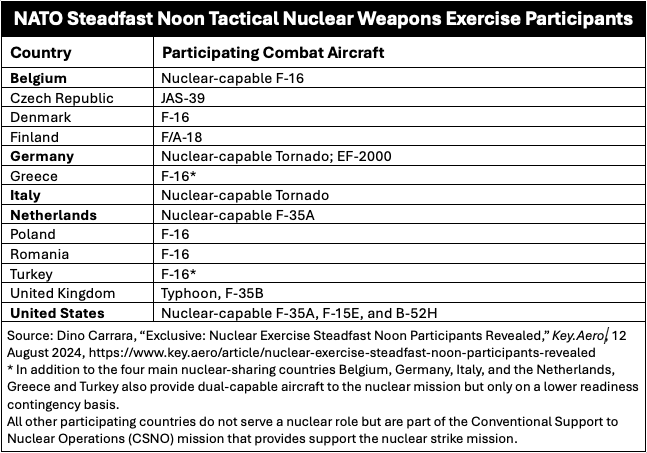
The thirteen countries match the number of participants identified in the NATO press release. Of these, Finland is obviously the most interesting – perhaps surprising – because the former neutral country has chosen to participate in a nuclear exercise only 18 months after it became a member of NATO.
Base Modernizations
The exercise coincides with major upgrades underway at most of the nuclear bases in Europe. This modernization involves security upgrades to the underground vaults that store the U.S. nuclear weapons, underground cables and nuclear command and control systems, and facilities needed for the new F-35A nuclear-capable fighter-bomber.
Several of the nuclear bases in Europe have recently seen construction of a special loading pad for use by the US C-17 aircraft that transport nuclear weapons and service equipment. This includes Kleine Brogel in Belgium, Ghedi in Italy, and Volkel in the Netherlands. The new pads at Ghedi and Volkel have walls to conceal the nuclear weapons transports. In this year’s Steadfast Noon exercise area, Kleine Brogel Air Base in Belgium has undergone extensive upgrades to weapons maintenance facilities, including the US Air Force 701st Munitions Support Squadron (MUNSS) – the unit responsible for the physical security and maintenance of the weapons, as well as for delivering custody of the weapons to the user country’s air forces if directed to do so. This includes a new drive-through facility for nuclear weapons maintenance trucks. In addition, a large tarmac for C-17A nuclear transport aircraft has been added next to the presumed nuclear weapons area, construction of a high-security facility possibly related to nuclear weapons maintenance has been nearly completed, a new control tower has been added, and underground cables and the Alarm Communication & Display (AC&D) system have been upgraded. Much of this was previously visible on satellite images on Google Earth and described by FAS last year, but since then the image has been removed and all images of the base on Google Earth have been blurred to obscure details. In the interest of nuclear transparency, the image is included here:

Clear images of Kleine Brogel Air Base are now gone from Google Earth. This one was available last year but has since been removed.
In the Netherlands, Volkel Air Base has gone the extra mile to hide operations by building a wall in front of a parking area where aircraft enthusiasts used to watch and film the aircraft. A spokesperson at the base confirmed the purpose of the new wall: “We believe it is important that personnel can work safely and undisturbed. The visibility-restricting measures make it difficult to photograph operational equipment and air base personnel.” For the first time, this Steadfast Noon exercise will include the Royal Netherlands Air Force’s newly nuclear-certified F-35A fighter-bombers.

Walls have been built at Volkel Air Base to hide weapons loading and prevent the public from observing operations and equipment.
The German base at Büchel is in the middle of a year-long upgrade that includes a service area for the F-35A at the northern end of the base, a refurbished runway, as well as what appears to be a security upgrade of the nuclear weapons area with a possible loading pad for the US C-17 transport aircraft that are used to transport nuclear weapons and limited life components.
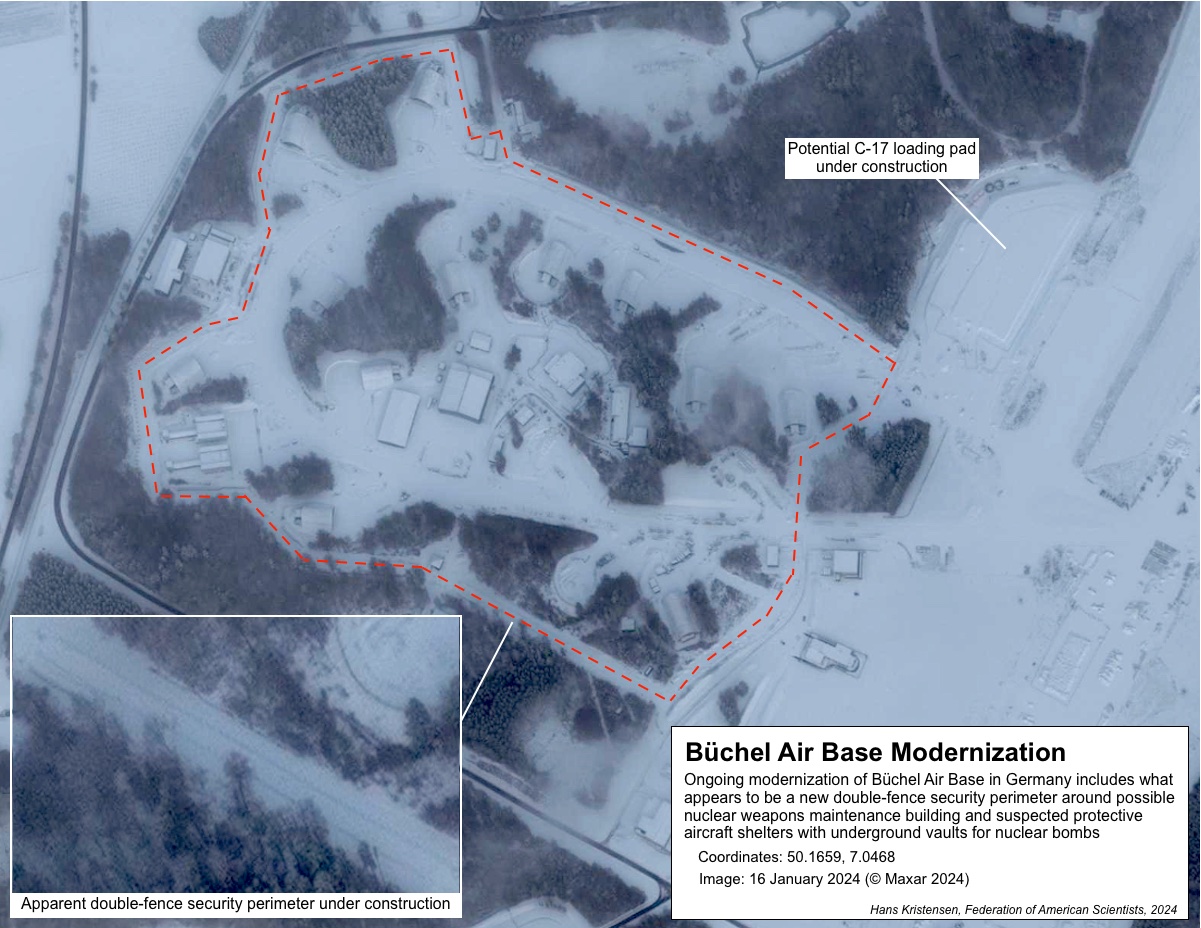
Modernization of Büchel Air Base in Germany appears to include a new double-fenced security perimeter around the nuclear shelters.
Finally, in this year’s Steadfast Noon operating area the most significant new development is the return of the nuclear mission to RAF Lakenheath, the home of the US Air Force 48th Fighter Wing with F-15E and F-35A fighter-bombers. The base previously was a major nuclear base with 33 underground storage vaults and over 100 nuclear bombs; but in the mid-2000s the US Air Force withdrew all the weapons and the nuclear mission was mothballed.
That began to change in 2022 when RAF Lakenheath was quietly added to the list of bases undergoing nuclear upgrades. Although the Pentagon tried to removed evidence of the change, other documents made it clear that the nuclear mission was returning. Satellite images of construction at RAF Lakenheath indicate that approximately 22 of the 33 protective aircraft shelters with underground WS3 vaults are involved in the nuclear upgrade.
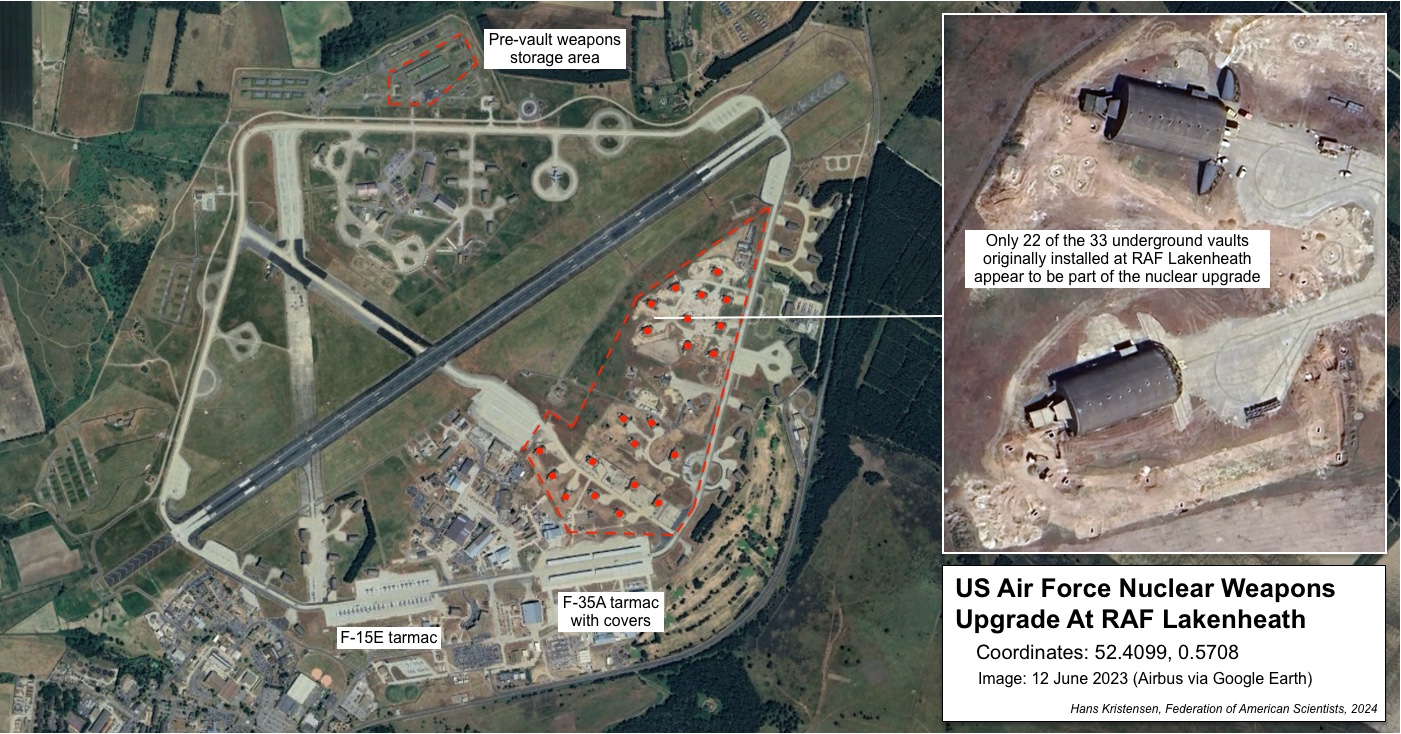
Return of the nuclear mission to RAF Lakenheath appears to include 22 of the original 33 protective aircraft shelters with underground weapons vault.
It is unclear if nuclear weapons will return to RAF Lakenheath or the upgrade is intended as a backup to increase flexibility and reduce vulnerability of the tactical nuclear weapons posture in Europe. After the 2016 coup attempt in Turkey and the policies of the Erdogan government, there has been speculations that the remaining weapons at Incirlik Air Base could be withdrawn; To that end it is interesting that the number of vaults that appear to be readied at RAF Lakenheath is about the same as the numbers remaining active at Incirlik.
Weapons Modernization
In addition to base and aircraft modernizations, the US Air Force is in the process of the replacing the legacy B61-3 and B61-4 tactical nuclear bombs with the new B61-12 guided nuclear bomb. The priority has been to supply the B-2 bombers at Whiteman AFB with the new weapon, but preparations are now underway to ship the B61-12 to bases in Europe and return the B61-3/4 bombs to the United States for dismantlement. The National Nuclear Security Administration (NNSA) reported recently that the B61-12 is technically certified for not only US Air Force fighter-bombers but also certified NATO aircraft (F-16, F-35A, and Tornado).

The B61-12 nuclear bomb is now technically certified on the B-2 bomber and all US and NATO dual-capable fighter aircraft.
It is unknown if the B61-12 has been shipped to Europe. NATO officials have only been willing to say preparations are underway. If so, it is unlikely to go to all bases at the same time or necessarily within a short period of time; Instead, the new weapon will probably replace the old weapons gradually depending on aircraft and base upgrade status.
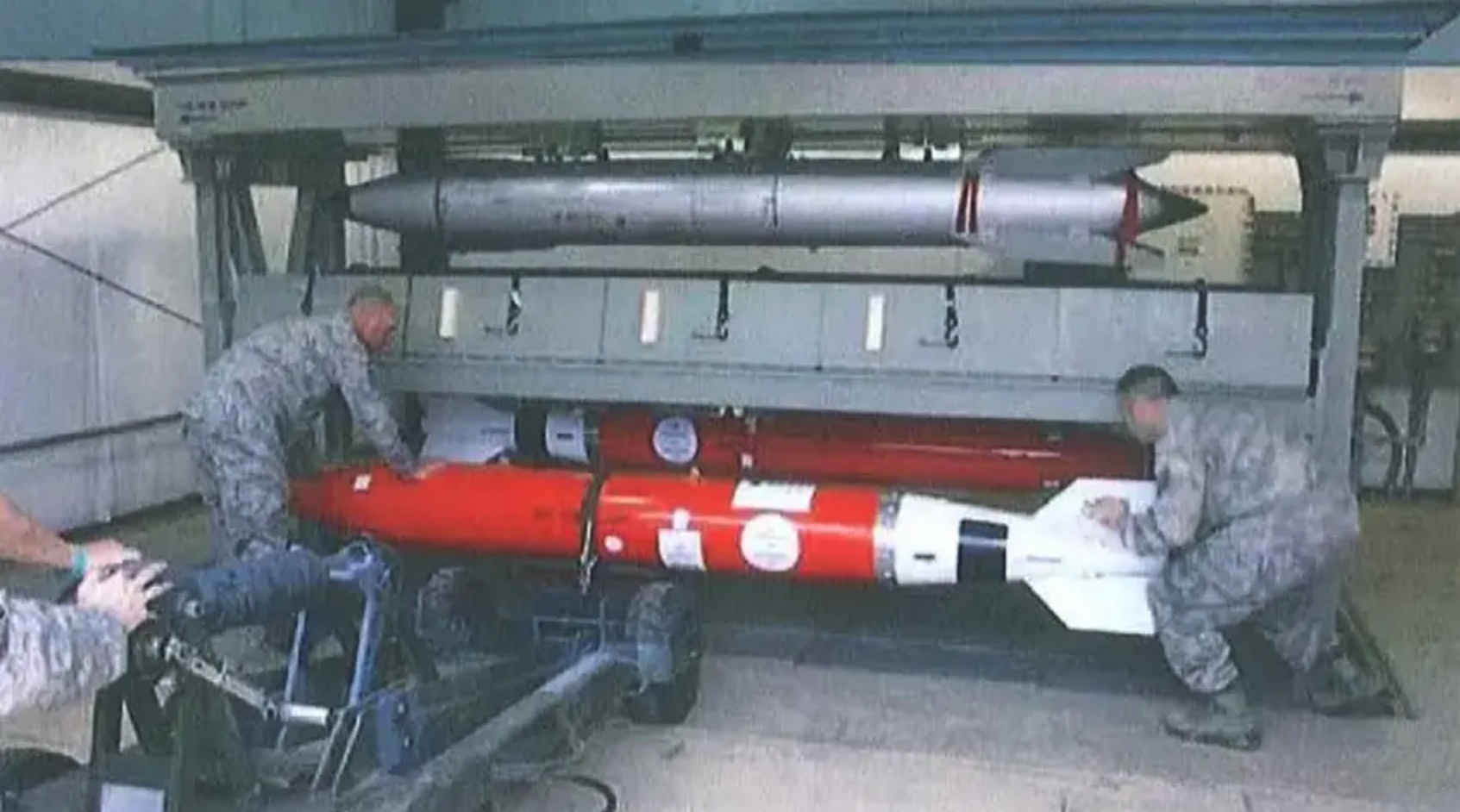
Load training of B61-12 (bottom) and legacy B61-4 (top) in a weapons storage vault of the kind installed at bases in Europe. Each vault can store up to four bombs but normally only have one or two. Image credit: US Air Force via The War Zone.
Our current estimate is that there are roughly 100 B61 nuclear bombs deployed in Europe at six bases in five countries. They constitute a small part of the total US nuclear stockpile of roughly 3,700 nuclear weapons.
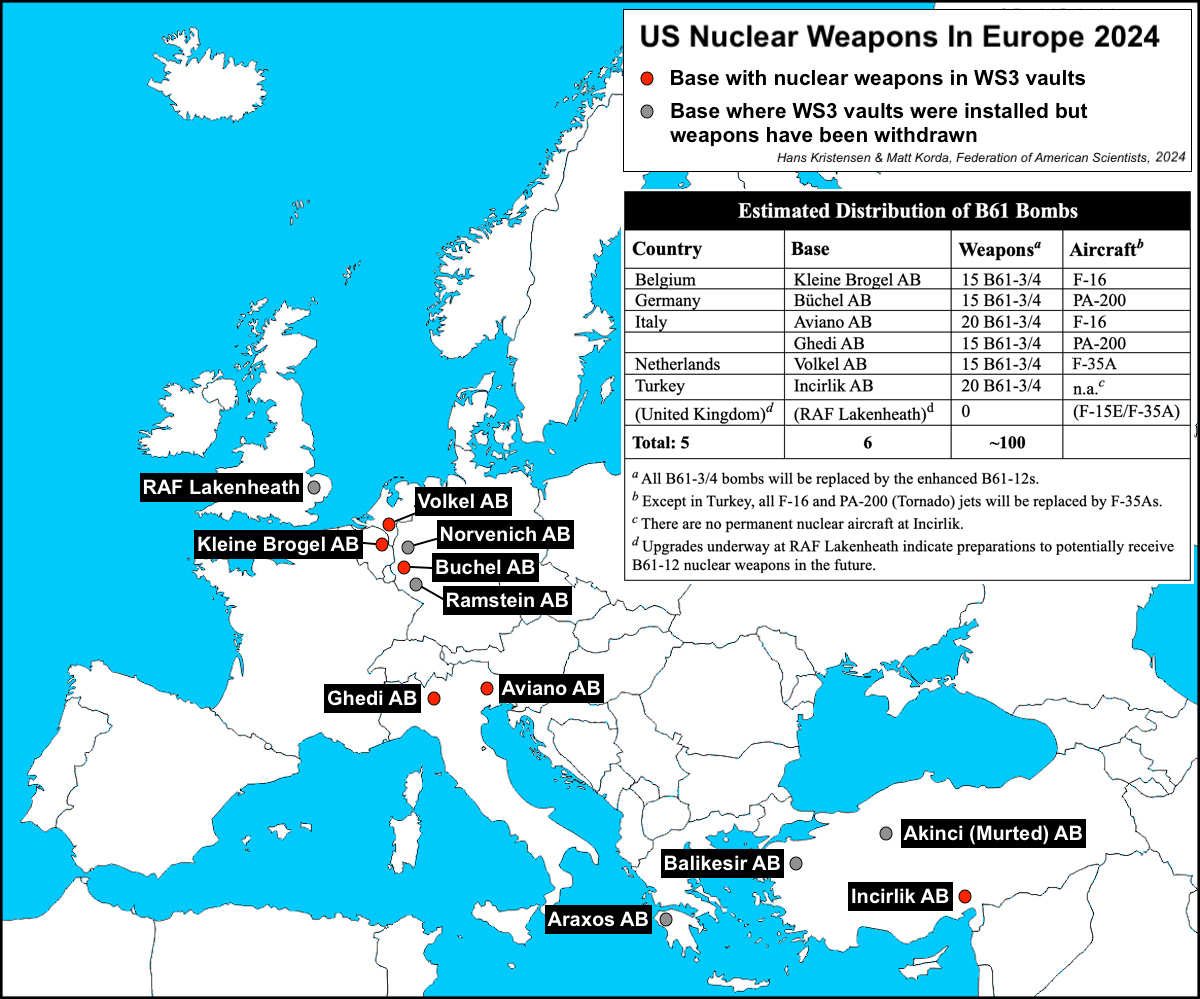
Broader Context
Steadfast Noon is an annual exercise and planning for this one began over a year ago, NATO says. Nonetheless, the two-week long tactical nuclear weapons exercise with over 60 aircraft from 13 countries is taking place during very tense relations with Russia who for nearly three years has waged a brutal full-scale war against Ukraine and issued numerous warnings to NATO about potential use of nuclear weapons.
Earlier this year, Russia held a series of diverse tactical nuclear weapons exercise and distributed pictures and videos to make sure it was noticed in the West. And most recently Russian president Vladimir Putin announced possible changes to Russia’s nuclear doctrine that appeared intended to signal a lower threshold for potential use of nuclear weapons.
In response, some analysts and institutes in the West are advocating for more nuclear weapons and broadening of the nuclear weapons sharing mission to more countries for what they believe is necessary to “strengthen deterrence” against Russia.
The United States has already increased the role and profile of nuclear bombers in support of NATO and US ballistic missile submarines have resumed visits to European ports – one submarine recently surfaced off Norway in a clear nuclear signal. In announcing the start of exercise Steadfast Noon, NATO Secretary General Mark Rutte said that “Steadfast Noon is an important test of the Alliance’s nuclear deterrent and sends a clear message to any adversary that NATO will protect and defend all Allies.” (Emphasis added.)
Combined, these action and reaction steps clearly have raised the nuclear profile over the past several years and are likely to be followed by more. With hardened rhetoric and increased signaling, the salience of nuclear weapons is again growing. Whether this will change the other sides’ behavior for the better or increase nuclear competition and risks even more remains to be seen.
This research was carried out with generous contributions from the Carnegie Corporation of New York, the Joseph Rowntree Charitable Trust, the New-Land Foundation, Ploughshares, the Prospect Hill Foundation, Longview Philanthropy, and individual donors.
The FY2026 National Defense Authorization Act (NDAA) paints a picture of a Congress that is working to both protect and accelerate nuclear modernization programs while simultaneously lacking trust in the Pentagon and the Department of Energy to execute them.
While advanced Chinese language proficiency and cultural familiarity remain irreplaceable skills, they are neither necessary nor sufficient for successful open-source analysis on China’s nuclear forces.
Satellite imagery has long served as a tool for observing on-the-ground activity worldwide, and offers especially valuable insights into the operation, development, and physical features related to nuclear technology.
This report outlines a framework relying on “Cooperative Technical Means” for effective arms control verification based on remote sensing, avoiding on-site inspections but maintaining a level of transparency that allows for immediate detection of changes in nuclear posture or a significant build-up above agreed limits.